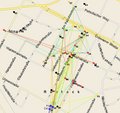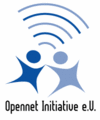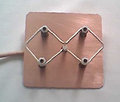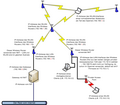Reise Djursland 2005
Inhaltsverzeichnis |
Programm
Diskussion im Forum: http://forum.opennet-initiative.de/thread.php?threadid=332
Wetter: http://www.wetteronline.de/Daenemark/Arhus.htm
Freitag
Abreise: 14 Uhr CSR Center, im Bus
Late arrival
Treffen in Friland, an der Adresse: Econ Pavillonen, Friland 12, Feldballe, 8410 Ronde (N 56.28038 E010.58765).
Samstag
- Breakfeast at Fuglsoecentret
- Visit to the Europeia Science Center
- Short presentation of DjurslandsNet and the new Djursland Networking Project
- Drive to the headquarter at the eco-sustainable village Friland
- Lunch / picnic
- Guided trip through the world of DjurslandsNet
- Presentation of new EU project for 15 new Community Networks in the Balticum
- BBQ dinner at Friland and social event
Sonntag
- Breakfeast at Fuglsoecentret
- Short presentation of Rostock OpenNet
- Discussion and ideas session for further cooperation
- Ad-hoc
- Lunch
- Departure
Reisedetails
Anreise
Fahrtdauer mit dem Auto: 6 - 7 Stunden
Unterbringung
Variante 1: Camping
Friland Feldhalle, Camping, free of cost, food costs 15 - 20 (Währung erfrage ich noch)
Variante 2: Fuglsoecentret
Kosten: 50 - 60 pro Person (Währung erfrage ich noch).
Organizer
Lokaler Organizer ist Gregers Petersen, den manche bereits von seinem Vortrag in Rostock kennen.
Seine Handy Nummer: +45 3024 8064
Abrechnung
| 247,00 EUR | Autoleih | Rene |
| ? EUR | Mehrkilometer Autoleih | Rene |
| 66,00 EUR | Tanken Dänemark | ? |
| ? EUR | Tanken Deutschland | ? |
| 140,00 EUR | Unterkunft | 100,- Ralf und 40,- Mathias |
| 75,00 EUR | Präsentkorb | Robert |
Buchungen
- Clemens Cap
- Robert Nickel
- Ralph Oesker
- Sebastian Hagen
- Mathias Mahnke
- Rene Ejury
- Friedrich Hartmann
Template Copy Paste
- Identität
- Kommunikation
- Anreise
- Unterbringung
Übersicht
| Wer | Anreise | Übernachtung |
|---|---|---|
| Clemens | Bus | Fuglsoecentret Single room |
| Robert | Bus | Zelt (bringt mit) |
| Ralph | Bus | Zelt (bringt mit) |
| Sebastian | Bus | Zelt (Mitschläfer) |
| Mathias | Bus | Zelt (bringt mit) |
| Rene | Bus | Zelt (Mitschläfer) |
| Friedrich | Bus | Zelt (Mitschläfer) |
Vortragsentwurf
Hier ein allererster Versuch die Inhalte unseres Vortrages zu strukturieren. Mir liegt vor allem daran, die kritischen Punkte unseres Wachstums zu beleuchten. Ich (Mathias) werde keine weiteren Änderungen mehr vornehmen.
Nachtrag C Cap: Vortrag fertig, bekomme ihn hier aber nicht hochgeladen (zu groß? falsche Dateitype?). Diskussion siehe Forum. Wir sollten ev. einen Bereich für große Uploads haben.
Gliederung
- introduction: Original motivation and project history
- technology
- officially supported Access Points - Linksys WRT54g and Asus WL-500g
- IEEE80.211 compliant WIFI (ad-hoc mode), IPv4, OLSR
- node types
- stationary nodes
- antennas placed on the roof
- APs placed inside flats or offices
- to maintain an effective infrastructure, the association owns and administers APs at some important locations
- mobile nodes
- basically just notebooks with wifi-cards that run OLSR
- usable anywhere in the area serviced by ON
- stationary nodes
- history of infrastructure development
- temporary installations for test purposes
- point-to-point connections using highly directional antennas
- growth; mixed use of directional antennas and omnidirectional antennas placed inside of buildings
- tendency of members to attempt to establish direct wifi-links to APs linked by LAN to an internet-gateway, stagnation
- growth and increase of redundant routes through increase in AP density and use of less directional antennas
- history of transmission protocols
- WDS; bridging; ethernet Spanning Tree Protocol to deactivate redundant routes
- ad-hoc mode; IPv4 routing; OLSR
- address spaces
- gateway "titan"
- SNAT Opennet -> Internet
- OpenVPN 2.0; authentication through certificates signed by our CA
- DNAT (i.e. port forwarding) to openvpn Addresses; currently 10 ports per user
- DSL; theoretical bandwith 3000/384 (kbit/s)?
- logging of individual connections
- Ocellata - Connection Quality; measured by using ICMP ECHO Requests
- Crinoidea (MySQLdb) - topN IP Addresses according to ON-Internet traffic caused
- Alfredi (PIM) - Maps with colored nodes and connections
- Ketupo (olsrd, olsrd_dd_ti, dot, Pydot) - Topology Dot Graphs
- Teucrium (netfilter, rrdtool, pyrddtool) - Traffic Graphs
- interfaces for users
- ethernet on their own AP
- possibility of using a second AP for private wireless use
- OpenVPN for internet-routing (endpoints on user-APs or client-systems)
- ethernet on their own AP
- Acccess Point Firmware
- started out using Sveasoft's Alchemy on Linksys, default FW on Asus APs
- current versions based on OpenWRT
- legacy ON FW: based on Freifunk-Firmware 1.0.2, minor modifications
- "Opennet Firmware" based on OpenWRT whiterussian (currently rc2) (several modifications, including the FFF-webinterface)
- web-based installation and configuration possible
- OpenVPN use on the AP explicitly supported; automated certificate creation
- individual extensions still possible, of course
- social issues
- general structure
- loosely organized, no pervasive hierarchical structure
- high importance of technologically skilled members
- day-to-day operation
- workshoops and meetings - also effective ways for interested persons to get involved
- documentation (e.g. HOWTOs) is collaboratively maintained on the ON wiki
- communication mostly per Forum, IRC and e-mail
- increasing interest in public relations issues
- motivation for individual members
- cheap internet access
- relatively fast internet access compared to the alternatives in areas without DSL coverage
- interest in technology / the community / ideological issues
- mobile internet access in the covered area
- general structure
- organisation
- some explicit internal rules
- responsibility for most of the infrastructure lies with AP-owners (i.e. individual members)
- individual competent members responsible for
- firmware design
- gateway administration
- management of jointly owned APs
- Public Relations
- support of new members
- future relevance
- connecting villages without broadband-coverage?
- supported by people interested in technological and social issues in areas covered by broadband
- mobile use
- guesstimated use of communication methods
- 45% - Forum (Wortlab Burning Board)
- 30% - Wiki (Mediawiki)
- 15% - Opennet IRC, increasing relevance
- 6% - Opennet mailing list (Mailman)
- 3% - Opennet Mail (apXX@..)
- 1% - Gallery
Wichtige Bilder
Weitere Bilder:















